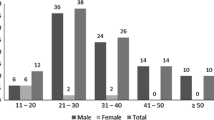Abstract
Le Fort fractures form a complex pattern of midfacial injury. They account for 10–20% of all maxillofacial fractures. They are usually the result of blunt trauma with a considerable amount of force. Motor vehicle accidents (MVAs) are the most common cause which are generally followed by assaults and trauma due to falls. Drugs and alcohol abuse often add to the incidence of these fractures. Management of Le Fort fractures should be focussed to prevent any life-threatening complications and restoration of appropriate form and function. This chapter focusses on the anatomical aspects, incidence and aetiology of Le Fort fractures and provides a diagnostic and treatment guideline to stabilise and manage the cases of Le Fort fractures.
Access this chapter
Tax calculation will be finalised at checkout
Purchases are for personal use only
Similar content being viewed by others
References
Noffze MJ, Tubbs RS. Rene le fort 1869-1951. Clin Anat. 2011;24(3):278–81.
Aksoy E, Unlu E, Sensoz O. A retrospective study on epidemiology and treatment of maxillofacial fractures. J Craniofac Surg. 2002;13:772–5.
Cienfuegos R. Lower midface. In: Ehrenfeld M, Manson PN, Prein J. Principles of internal of the craniomaxillofacial skeleton- trauma and orthognathic surgery. Thieme, Stuttgart. 2012:183–193.
Gentile MA, Tellington AJ, Burke WJ, Jaskolka MS. Management of midface maxillofacial trauma. Atlas Oral Maxillofac Surg Clin North Am. 2013;21(1):69–95.
Kiley HC. Classification. In: Derrick DD, editor. Fractures of the middle third of the facial skeleton. 2nd ed. Bristol: John Wright and Sons; 1974. p. 11–5.
Malik NA. Fractures of the middle third of the facial skeleton. In: Malik NA, editor. Textbook of oral and maxillofacial surgery. 2nd ed. New Delhi: Jaypee; 2008. p. 349–63.
Marciani RD. Management of midface fractures: fifty years later. J Oral Maxillofac Surg. 1993;51(9):960–8.
Haug RH, Greenberg AM. Etiology, distribution, and classification of fractures. In: Greenberg AM, editor. Craniomaxillofacial fractures—principles of internal fixation using the AO/ASIF technique. New York: Springer; 1993. p. 5–20.
Hendrickson M, Clark N, Manson P, et al. Palatal fractures: classification, patterns and treatment with rigid internal fixation. Plast Reconstr Surg. 1998;101(2):319.
Phillips BJ, Turco LM. Le fort fractures: a collective review. Bull Emerg Trauma. 2017;5(4):221–30.
Rowe NL. Fractures of the facial skeleton in children. J Oral Surg. 1968;26(8):505–15.
Holier H, Thorton J, Pazmino P, et al. The management of orbital facial fractures. Curr Opin Opthalmol. 2003;14:236–40.
Ellis E, Zide MF. Periorbital approaches. In: Ellis E, Zide MF, editors. Surgical access to the facial skeleton. Baltimore: Williams and Wilkins; 1995. p. 7–54.
Appling WD, Patrinely JR, Salzer TA. Transconjunctival approach vs subciliary skin muscle flap approach for orbital fracture repair. Arch Otolaryngol Head Neck Surg. 1993;119:1000–7.
Ridgway EB, Chen C, Colakoglu S, et al. The incidence of lower eyelid malposition after facial fracture repair: a retrospective study and meta-analysis comparing subtarsal, subciliary, and transconjunctival incisions. Plast Reconstr Surg. 2009;124:1578–86.
Kharkar VR, Rudagi BM, Halli R, et al. Comparison of the modified lateral orbitotomy and modified hemicoronal approach in the treatment of unstable malunions of zygomatic complex fractures. Oral Surg Oral Med Oral Pathol Oral Radiol Endod. 2010;109:504–9.
Bowerman JE, Fordyce GL, Levant BA. Fractures of the middle third of facial skeleton. In: Rowe NL, Williams JL, editors. Maxillofacial injuries, vol. 1. Edinburgh: Churchill Livingstone; 1985. p. 363–434.
Crawley WA, Azman P, Clark N, et al. The edentulous Le fort fracture. J Craniofac Surg. 1997;8(4):298–307.
Farmand M, Bauman A. The treatment of the fractured edentulous maxilla. J Craniomaxillofac Surg. 1992;20:341–4.
Holland IS, McMohan JD, Koppel DA, Devlin MF, Moos KF. Maxillary and panfacial fractures. In: Booth PW, Eppley BA, Schmelzeisen R, editors. Maxillofacial trauma and esthetic facial reconstruction. 2nd ed. St. Louis: Saunders; 2012. p. 228–51.
Chen WJ, Yang YJ, Fang YM, Xu FH, Zhang L, Cao GQ. Identification and classification in le fort type fractures by using 2D and 3D computed tomography. Chin J Traumatol. 2006;9(1):59–64.
Beogo R, Bouletreau P, Konsem T, Traore I, Coulibaly AT, Ouedraogo D. Wire internal fixation: an obsolete, yet valuable method for surgical management of facial fractures. Pan Afr Med J. 2014;17:219.
Salonen EM, Koivikko MP, Koskinen SK. Multidetector computed tomography imaging of facial trauma in accidental falls from heights. Acta Radiol. 2007;48(4):449–55.
Bagheri SC, Holmgren E, Kademani D, Hommer L, Bell RB, Potter BE, et al. Comparison of the severity of bilateral le fort injuries in isolated midface trauma. J Oral Maxillofac Surg. 2005;63(8):1123–9.
Girotto JA, MacKenzie E, Fowler C, Redett R, Robertson B, Manson PN. Long-term physical impairment and functional outcomes after complex facial fractures. Plast Reconstr Surg. 2001;108(2):312–27.
Kaul RP, Sagar S, Singhal M, Kumar A, Jaipuria J, Misra M. Burden of maxillofacial trauma at level 1 trauma center. Craniomaxillofac Trauma Reconstr. 2014;7(2):126–30.
Jarupoonphol V. Surgical treatment of le fort fractures in ban pong hospital: two decades of experience. J Med Assoc Thai. 2001;84(11):1541–9.
Author information
Authors and Affiliations
Editor information
Editors and Affiliations
Rights and permissions
Copyright information
© 2021 The Author(s), under exclusive license to Springer Nature Singapore Pte Ltd.
About this chapter
Cite this chapter
Sharma, N.K., Mishra, N. (2021). Le Fort Fractures. In: Singh, A.K., Sharma, N.K. (eds) Maxillofacial Trauma. Springer, Singapore. https://doi.org/10.1007/978-981-33-6338-0_16
Download citation
DOI: https://doi.org/10.1007/978-981-33-6338-0_16
Published:
Publisher Name: Springer, Singapore
Print ISBN: 978-981-33-6337-3
Online ISBN: 978-981-33-6338-0
eBook Packages: MedicineMedicine (R0)




